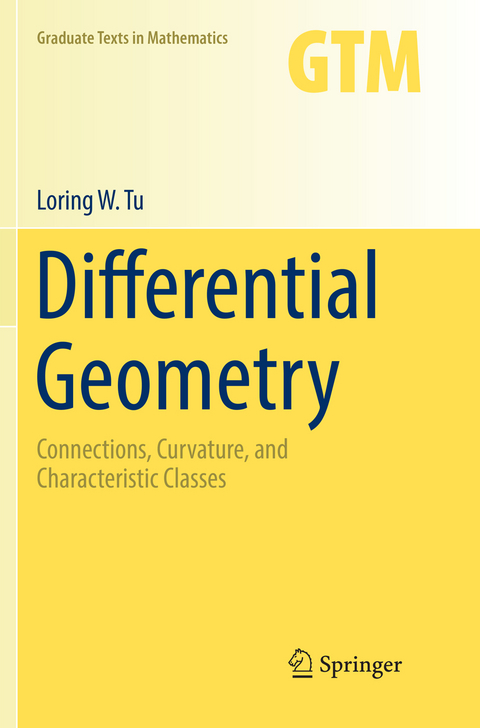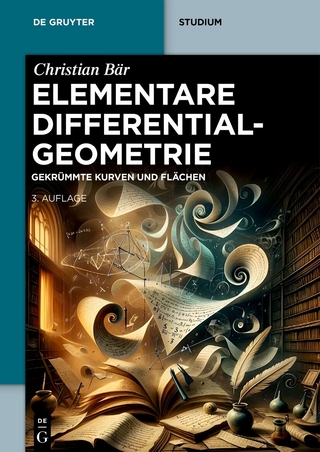
Differential Geometry
Springer International Publishing (Verlag)
978-3-319-85562-2 (ISBN)
Prerequisite material is contained in author's text An Introduction to Manifolds, and can be learned in one semester. For the benefit of the reader and to establish common notations, Appendix A recalls the basics of manifold theory. Additionally, in an attempt to make the exposition more self-contained, sections on algebraic constructions such as the tensor product and the exterior power are included.
Differential geometry, as its name implies, is the study of geometry using differential calculus. It dates back to Newton and Leibniz in the seventeenth century, but it was not until the nineteenth century, with the work of Gauss on surfaces and Riemann on the curvature tensor, that differential geometry flourished and its modern foundation was laid. Over the past one hundred years, differential geometry has proven indispensable to an understanding of the physical world, in Einstein's general theory of relativity, in the theory of gravitation, in gauge theory, and now in string theory. Differential geometry is also useful in topology, several complex variables, algebraic geometry, complex manifolds, and dynamical systems, among other fields. The field has even found applications to group theory as in Gromov's work and to probability theory as in Diaconis's work. It is not too far-fetched to argue that differential geometry should be in every mathematician's arsenal.
Loring W. Tu was born in Taipei, Taiwan, and grew up in Taiwan, Canada, and the United States. He attended McGill and Princeton as an undergraduate, and obtained his Ph.D. from Harvard University under the supervision of Phillip A. Griffiths. He has taught at the University of Michigan, Ann Arbor, and at Johns Hopkins University, and is currently Professor of Mathematics at Tufts University. An algebraic geometer by training, he has done research at the interface of algebraic geometry, topology, and differential geometry, including Hodge theory, degeneracy loci, moduli spaces of vector bundles, and equivariant cohomology. He is the coauthor with Raoul Bott of Differential Forms in Algebraic Topology and the author of An Introduction to Manifolds.
Preface.- Chapter 1. Curvature and Vector Fields.- 1. Riemannian Manifolds.- 2. Curves.- 3. Surfaces in Space.- 4. Directional Derivative in Euclidean Space.- 5. The Shape Operator.- 6. Affine Connections.- 7. Vector Bundles.- 8. Gauss's Theorema Egregium.- 9. Generalizations to Hypersurfaces in Rn+1.- Chapter 2. Curvature and Differential Forms.- 10. Connections on a Vector Bundle.- 11. Connection, Curvature, and Torsion Forms.- 12. The Theorema Egregium Using Forms.- Chapter 3. Geodesics.- 13. More on Affine Connections.- 14. Geodesics.- 15. Exponential Maps.- 16. Distance and Volume.- 17. The Gauss-Bonnet Theorem.- Chapter 4. Tools from Algebra and Topology.- 18. The Tensor Product and the Dual Module.- 19. The Exterior Power.- 20. Operations on Vector Bundles.- 21. Vector-Valued Forms.- Chapter 5. Vector Bundles and Characteristic Classes.- 22. Connections and Curvature Again.- 23. Characteristic Classes.- 24. Pontrjagin Classes.- 25. The Euler Class and Chern Classes.- 26. Some Applications of Characteristic Classes.- Chapter 6. Principal Bundles and Characteristic Classes.- 27. Principal Bundles.- 28. Connections on a Principal Bundle.- 29. Horizontal Distributions on a Frame Bundle.- 30. Curvature on a Principal Bundle.- 31. Covariant Derivative on a Principal Bundle.- 32. Character Classes of Principal Bundles.- A. Manifolds.- B. Invariant Polynomials.- Hints and Solutions to Selected End-of-Section Problems.- List of Notations.- References.- Index.
"The textbook is a concise and well organized treatment of characteristic classes on principal bundles. It is characterized by a right balance between rigor and simplicity. It should be in every mathematician's arsenal and take its place in any mathematical library." (Nabil L. Youssef, zbMATH 1383.53001, 2018)
“The textbook is a concise and well organized treatment of characteristic classes on principal bundles. It is characterized by a right balance between rigor and simplicity. It should be in every mathematician's arsenal and take its place in any mathematical library.” (Nabil L. Youssef, zbMATH 1383.53001, 2018)
| Erscheinungsdatum | 05.03.2022 |
|---|---|
| Reihe/Serie | Graduate Texts in Mathematics |
| Zusatzinfo | XVII, 347 p. 87 illus., 15 illus. in color. |
| Verlagsort | Cham |
| Sprache | englisch |
| Maße | 155 x 235 mm |
| Gewicht | 6232 g |
| Themenwelt | Mathematik / Informatik ► Mathematik ► Geometrie / Topologie |
| Schlagworte | Christoffel Symbols • Codazzi-Mainardi equation • Codazzi–Mainardi equation • Gauss–Bonnet theorem • Gauss-Bonnet Theorem • Gauss Curvature equation • Gauss Theorema egregium • Gram-Schmidt process • Gram–Schmidt process |
| ISBN-10 | 3-319-85562-X / 331985562X |
| ISBN-13 | 978-3-319-85562-2 / 9783319855622 |
| Zustand | Neuware |
| Haben Sie eine Frage zum Produkt? |
aus dem Bereich


